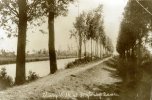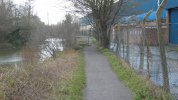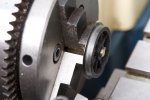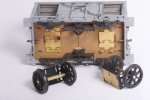Part 1: The Story of the Railway
Historical Background
Beginnings
Heybridge is a large village and civil parish near the estuary of the River Blackwater in Essex. The settlement here grew and prospered during the 18th and 19th centuries, due largely to the presence of a navigable waterway (the Chelmer and Blackwater Navigation) and the success of a firm of agricultural engineers, E H Bentall.
Records from the 1670s show a suggestion to turn the River Chelmer into a navigable waterway from Chelmsford to Maldon, but the people of Maldon opposed the plan and it was dropped. About a century later, a fresh scheme was proposed, and this met with support from people living in and around Chelmsford (where benefits would be felt) but again fierce opposition from the Maldonians who knew the owners of the waterway would take away their incomes from the tolls, harbour dues and wharfage fees. In response, the Chelmer and Blackwater Navigation was built to Heybridge Basin, missing out Maldon altogether.
By the 1840s there was a prospect of a railway between Maldon and Witham, and the tradesmen of Heybridge sent in a petition that the railway should go to Chelmsford rather than to Witham. One of the signatories was E H Bentall, and it is interesting to observe that, while the merchants of Heybridge owed their existence to the navigation, they had no scruples whatsoever in seeking an association with a railway which would put the navigation out of business overnight.
Much of the support for a line from Maldon to Witham came from Braintree; the businesses of Braintree would benefit from the easy import of coal, coke, iron, oil cake, tar, slates and other raw materials. After losing the navigation the Maldonians were keen to not miss out again, and this explains why a dock was built beside the station at Maldon. The direct line to Chelmsford was never built.
The Maldon, Witham and Braintree Railway Company obtained parliamentary sanction for a new railway including a line from Witham to Maldon via Langford; Heybridge was not in their sights. The Eastern Counties Railway took over the project and opened the new railway from Maldon to Braintree in 1848.
The Navigation
The Chelmer and Blackwater Navigation was completed in 1797 when it reached Springfield basin in Chelmsford. The navigation brought coal from North East England and timber from Scandinavia to Chelmsford, and also carried flour from the mills at Langford and Paper Mill Lock.
The navigation was responsible for the creation of the settlement at Heybridge Basin, and helped Heybridge itself to grow; and carried commercial traffic while Chelmsford transitioned from being a small market town on the London to Norwich road into the prosperous County Town.
The Bentall Company
The Bentall company of agricultural engineers moved from Goldhanger to Heybridge in the early 19th century. They chose Heybridge because they could use the navigation to bring in bulky raw materials like iron and coke, and to export their finished products. In common with other ironfounders, the company found a steady demand for general castings as well as agricultural implements, and these too left the works by way of the navigation.
Heybridge had already developed after the arrival of the navigation, and the subsequent expansion of the Bentall company changed the settlement from being an agricultural village with ten farms to a ‘factory town’ manufacturing agricultural machinery.
The Foundry
During the early 19th century, William Bentall established a foundry in Heybridge. General castings as well as agricultural implements were in steady demand: grates, range backs, doorscrapers, grave markers and barge wheels; and any parts for other tradesman which he was commissioned to manufacture. The largest castings weighed 10 tons.
The foundry received its pig iron by sea, shipped from the North East of England. Pig iron was stored in wharfs along the side of the navigation, typically a thousand tons was held in stock.
The Tramway
The Bentall works had an internal tramway system which connected many of the buildings together.
The Bentall Car
In 1904, E H Bentall embarked on a well-intended but ultimately disastrous venture into the fledgling motor industry. Edward Ernest bought one of the first two cars and became the first person in Heybridge to own a motor car.
E H Bentall went into full production of their car in 1905, with their foundry producing most of the components. The agent for selling the cars was Glovers of Witham.
The engine was a four-cylinder, 2,418 cc bi-block design giving the car a maximum speed of 28 mph. The engine was over-square (a design with a relatively large cylinder bore and a short stroke), and sadly the British government began to tax cars according to the diameter of their cylinders. This meant the tax was lower on cars with a longer stroke and a smaller bore, such as the Ford mono-block engine, and the Bentall car became impossible to sell. E H Bentall had invested £60,000 in tooling for their car (a sum equivalent to about £7m in 2021) and they had to make drastic savings. They stopped producing the car in 1912, after building about 100 cars.
(E&OE)
The Heybridge and Langford Light Railway Company
My story begins on a December evening in 1887, when the directors of E H Bentall found themselves enjoying a few beers with the owners of the navigation in the Heybridge Inn. By now, the scant regard shown by E H Bentall to the navigation before the coming of the Maldon railway had been gracefully forgotten, and indeed the two companies now worked side by side. The navigation brought fuel and raw materials to Bentalls, and carried away the agricultural products for export.
Heybridge was thriving, but both parties feared being ‘left behind’ now the railways had established themselves throughout Great Britain. The nearest railhead was at Maldon (the terminus of the Great Eastern branch from Witham), most of a mile away and reached by way of a rutted and unmaintained road; and the navigation, whilst extending most of twelve miles to Chelmsford, lacked a direct interchange with a railway.
The provision of a short railway from Heybridge Basin through Heybridge to join the Great Eastern Railway near Langford was an affordable and practical link, needing no significant earthworks or bridges. In fact, the route of the line was almost ready-made across open fields. Two level crossings would be needed: one to let the railway cross the road beside Wave Bridge (1), and a second across the farm track leading to Wickham Bishops near the northern end of Holloway Road.
The railway would provide a new means of communication and help the economy of the region to grow. The railhead at Heybridge Basin would let the basin compete with the dock at Maldon, with new coastal traffic bringing freight for Witham and Braintree and beyond. The basin would also allow transhipment of specialised wagonload freight too small to justify an entire barge. The idea appealed to Bentalls very much, they were becoming frustrated by the delays and damage caused by wheel and axle fractures during transit along the road to Maldon station.
Both companies wanted to attract more workers, and a rail link would let them tap into the growing population of Witham. Logically, the railway would also attract completely new businesses to Heybridge, in particular the commercial harvesting of salt. After some careful deliberation and of course some more beers, the Heybridge and Langford Light Railway Company was duly formed. The shareholders comprised Bentalls and the navigation; and also the Earl of Langford, a local landowner who rather fancied a private station along the route.
The railway would be built as a light railway as defined by the Regulation of the Railways Act of 1868, and in January 1888 the company submitted a formal Notice of Application to the Board of Trade. The primary reason for the Notice of Application was to obtain permission to run passenger trains.
The Board of Trade received no formal objections or representations, and duly granted the company a Licence to construct and operate their branch line as a Light Railway. The maximum axle weight would be 8 tons and speeds would be no higher than 25 mph, in accordance with the provisions of the Act of 1868.
Construction and Opening of the Railway
The construction of the railway was helped a great deal by the fact that the Earl of Langford and the navigation owned all of the land along the route. The Company decided to build their railway in two stages. The section from Heybridge to Langford would be first, and the extension to Heybridge Basin would follow after the business had gained sufficient receipts.
The company promptly engaged the services of T A Walker contractors to build the first stage of the railway, and construction started in 1888. Walker’s had substantial experience of railway work from their efforts on the Manchester Ship Canal, and brought with them a Manning Wardle K class locomotive to do the work. Hitherto unseen records show this locomotive to have been MW works number 1032, completed and supplied in 1888.
Construction was swift and the railway opened in the autumn of 1889 to connect Heybridge with the Great Eastern Railway near Langford, on their branch line from Witham to Maldon.
Map of the Heybridge Railway (external link to Google Maps)
The rails at Heybridge stopped just short of Goldhanger Road, with modest but adequate facilities provided for freight and passengers. Heybridge station provided a low platform with a simple wooden shelter, and the Company set up its offices beside the station. Langford North station served as a public interchange with the GER branch to Maldon, and as a private station for nearby Langford Hall.
From the limited accounts I have been able to find, the new railway probably opened to the public on Wednesday 3rd October 1889. This event was not reported in the local press; we can imagine it was overshadowed by the news of the long-awaited line from Maldon West to Woodham Ferrers, which had opened on the previous day.
Around 1892, the foundry built a self-contained standard-gauge railway of its own. This was inside the works of E H Bentall and I imagine it was the "tramway" recorded in more authoritative histories.
The extension of the line to Heybridge Basin followed in 1894. The railway wrote to the local council to request permission to construct the level crossing over Goldhanger Road, but did not receive a timely reply. The contractors therefore proceeded to build the crossing, improving the road in the process. The council discovered the level crossing some months later and decided that the road was now in such an improved condition they could only thank the railway company for their work.
The railway ran beside the towing path for the remaining mile to Heybridge Basin, where wagonload freight was transhipped to and from coastal vessels and, less frequently, to and from the barges using the navigation. The operations of the railway complemented those of the navigation and did not compete with them. Around this time, a bridge was erected across the navigation at Heybridge to connect the railway to the foundry inside the Bentall works.
The Heybridge and Langford Light Railway was now complete.
- -
(1) The present Colchester Road (B1022) at Wave Bridge is called Goldhanger Road or Broad Street Green Road in some historical accounts.
(2) The Ordnance Survey 6 inch map 1888 - 1913 of Heybridge shows Wave Bridge as Goldhanger Bridge but this name has not appeared in any historical accounts In have seen.










